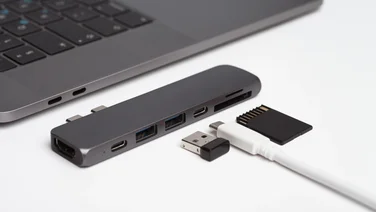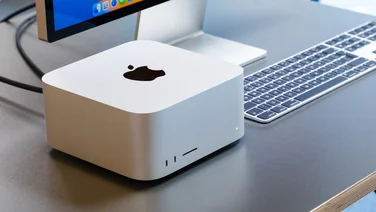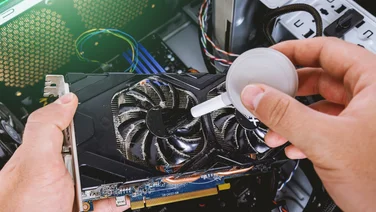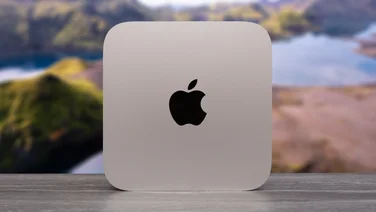To help us provide you with free impartial advice, we may earn a commission if you buy through links on our site. Learn more

Mini PCs open up all kinds of possibilities for a business, whether its removing clutter on the desktop, saving space in a till or reception area, or even integration directly into products or customer displays. HP’s latest range of EliteDesk G1 800 Desktop Mini PCs are designed with hardware and software to suit a business’ needs. Here we’re reviewing the new range-topping model, with a 256GB solid-state drive (SSD), 8GB of RAM and an Intel Core i7-4765T processor clocked at 2.0GHz, with a maximum Turbo frequency of 3.0GHz.
However, we think the processor may be a bit too powerful for the tasks people will undertake with a compact PC. The core i7-4765T has plenty of power to handle run-of-the-mill applications, but it isn’t ideal for use as a workstation. There’s no slot for a discrete graphics adaptor, for instance, and no room in the miniscule chassis for a large data drive.
Even so, the EliteDesk 800 G1 is a neat PC. It looks inconspicuous, and has only a power switch, audio ports and two USB3 ports on the front of it. At the rear are a further four USB3 ports, a gigabit Ethernet port, an audio output, two DisplayPort outputs and a VGA output. Sadly, there’s no HDMI output. This PC doesn’t come with a display, so you can choose your own or re-use an old. You do, however, get an ordinary USB keyboard and mouse, as well as a stand for mounting the PC vertically.
The chassis cover is secured with a single thumbscrew for quick access, but there’s a padlock loop should you need to prevent others opening the PC. Conveniently, there’s also a tamper switch that will register if anybody has. Inside the PC is a tool-free disk caddy, which makes it easy to lift out the SSD and insert a SO-DIMM memory module in the empty slot underneath. Also under the disk caddy is an M.2 slot, which is already populated in our sample by a dual-band Intel N7260 wireless card. To access the M.2 slot you must remove the caddy, which is secured by Torx T15 bolts.

HP preinstalls this PC with Windows 7 Professional 64-bit, and there’s an 11GB recovery partition that you can use to restore you PC to its factory condition, should you need to. HP also supplies Windows Setup and driver discs for both Windows 7 and Windows 8.1, so you could install Windows 8.1 instead should prefer it, but you’ll need an external optical drive to do so.
The other bundled software is useful and, thankfully, doesn’t bloat the disk with unwanted software. Software, driver and firmware updates are handled by the HP SoftPaq Download Manager, which lets you choose which updates to apply and when. You can also use it to build a catalogue file for rolling out to other computers, which is very useful if you buy batches of similar PCs and want to minimise the administration and bandwidth of keeping them all updated.
Also of interest is HP Client Security, which manages features including disk encryption, password recovery and device restrictions, which is useful to stop unauthorised users copying data to a USB drive, for example. The standard package includes Trust Circles, which is used for sharing confidential data with other authorised users, but the Theft Recovery program shortcut leads only to an advert for third-party software. We were also disappointed that Client Security let us set a password of ‘password’ – it warned that it was weak based on the lack of uppercase, numbers or symbols, but such a useless choice should be blocked altogether.
Although this mini-PC uses an SSD rather than a hard disk, its fan means it isn’t silent in use, even when idle. The fan speed seems to rise little under load, however, so any noise it makes will be drowned out in an office environment. Power use remains light at all times, and we measured a peak of 37 watts during our benchmark tests, and this fell to around 7w when the PC was idle and 1w when it was asleep. There’s no obvious heat other than a gentle warming of the case above the cooler.
You might expect a mini PC to struggle when benchmarking, but the EliteDesk 800 G1 did surprisingly well, scoring 76 overall in our PC benchmark tests. Less surprising was this PC’s comparatively weak performance on 3D accelerated tasks due its use of the Core i7-4765T’s built-in graphics processor. Although this PC is clearly not intended for gaming, we ran our Dirt Showdown benchmark at a resolution 1,280×720 with 4x anti-aliasing and High graphics quality to get an idea of how it would perform. The Elitedesk 800 G1 produced an average frame rate of 24 frames per second, which does demonstrate that it can handle basic 3D work. You’ll certainly have no trouble web browsing and using common applications such as the MS Word and Excel.
We like the Elitedesk 800 G1 Desktop Mini, particularly its sensible software suite and design. However, the specification we reviewed is best for those who really do need the extra power afforded by the Core i7-4765T. If you’ll primarily be undertaking basic office duties such as word processing and web browsing, it’d be better to specify less a less powerful processor and save a bit of money. Alternatively, you could consider the cheaper and Best Buy-winning Scan 3XS NUC N16 if you simply want a compact PC, although you’d be sacrificing all the business-oriented goodies of the Elitedesk 800 G1 Compact Mini if you do.






